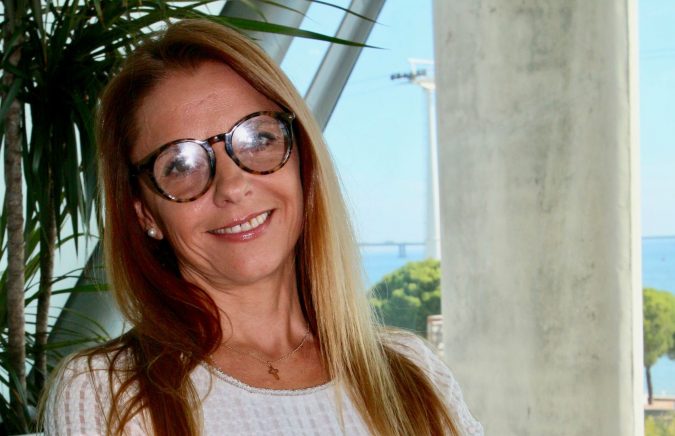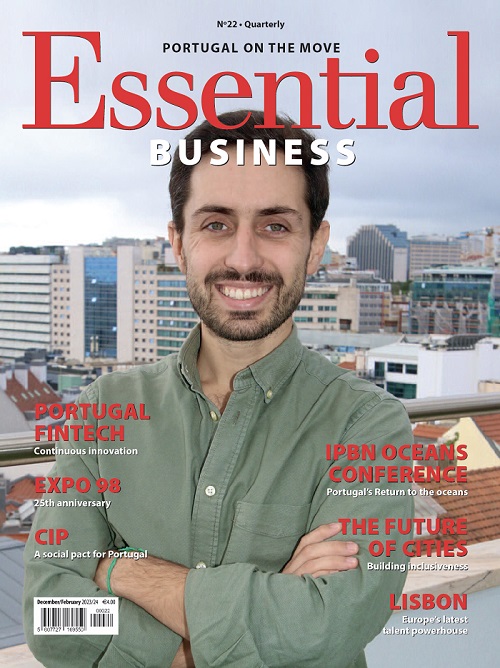Sandra Fragoso – the woman behind SIL
For eight years Sandra Fragoso has been the woman behind the smooth organisation of one of Europe’s most important property fairs – SIL (Salão de Imobiliária de Lisboa). In that time she has seen the market go from boom to bust and now a recovery that has been partly — and in no small measure — down to the ingenuity and dedication of her team working new markets overseas and innovating with strategies, campaigns and new technological platforms.
Portugal’s most important property fair SIL begins Wednesday with visitor numbers expected to break records and 350 exhibitors with stands covering double the area on 2017.
The five-day Salão Imobiliária de Lisboa (SIL), which runs from 3-7 October and now in its 21st edition, is the meeting point for overseas property investors and developers interested in doing business in Portugal and the Portuguese-speaking world.
Sandra Fragoso, event manager, says that this year’s fair has doubled in size due to the sheer “demand of a booming real estate industry in Portugal” with two pavilions instead of one.
Sandra explains that over the five days visitors and investors will be able to “find their ideal home or office” while investors, both Portuguese and overseas, will get the perfect opportunity to network, make contacts and do business deals.
A number of local banks will also attend the fair offering the best credit conditions while service suppliers linked to the sector will also be in evidence.
“This is a unique opportunity to have a comprehensive property industry product under one roof” adds Sandra.
The event will reflect the “sector’s positive development” both in terms of internal and foreign investment which is why the fair has attracted ever increasing annual numbers.
In 2017 there were a record 62,639 visitors compared to the 50,000 in 2016 while there were 330 exhibitors in 2017 compared with 300 in 2016.
“We expect that this edition will attract around 65,000 visitors and we have signed up 350 companies, breaking another record for SIL” she adds.
This year the spotlight will be on the Tagus south bank city of Seixal through SIL’s programme SIL Cidades (SIL Cities) at which will be unveiled the ambitious development plans for one of Lisbon’s newest and most exciting investment opportunities.
From boom to bust
Sandra Fragoso joined FIL (Feira Internacional de Lisboa) before the crisis which brought Portugal’s construction and real estate sectors to a standstill and at a time when the property business was booming, especially in Angola and Brazil.
“At that time our team at SIL was riding on the crest of a successful wave for the Portuguese property sector with fantastic growth with the fair occupying three pavilions, one of which was mostly taken by Brazilian companies and developers at a time when Portugal was investing a lot in Brazil” Sandra recalls.
“From 2008 we were caught up in the economic crisis which badly affected the sector. Those players that had had a very strong presence just vanished,” she remembers.
The fair organiser points out that trade fairs are, in many ways, a barometer for the overall economy and SIL had to create strategies and tools to combat the downturn and help keep the industry alive.
Her team managed to survive, some years with more companies, other years with less, so that those players who were still operating in the sector would be present. As Sandra Fragoso points out, SIL was and still is a meeting point for different companies and professionals in the sector to network and do business. It was crucial during the recession years for them to be visible to potential investors to show they had survived and were still in the market.
“Those that were still working considered SIL to be one of the most important property fairs in Europe and still do because it brings in business, contacts and the good brand name that is Salão de Imobiliária de Lisboa” she says.
The strategy then as now was to invite key investors to SIL, get them involved in the parallel activities, workshops, talks and conferences that we organise and are a draw and asset for the sector in understanding the local market. “We downscaled but we never gave up and simply waited for the next wave” she says.
A buoyant market
Since Portugal’s property sector showed signs of turning the corner from 2015, SIL has experienced a year-on-year increase not only exhibitors and visitors, but also foreign investors.
Says Sandra Fragoso, “We had this strategy of organising SIL at the same time as other events which have a real estate connection such as Intercasa – the leading home décor and furnishings fair in Portugal, as well as LXD, a designers fair and the Vintage Festival.
“Through these synergies and symbiotic partnerships we managed to successfully create added value for the exhibitors who benefitted and the visitors looking to buy a home and get a good mortgage deal who were also able to see the latest trends in design and furniture.”
At that time SIL, together with the bank Caixa Geral de Depósitos, organised property auctions selling off apartments and houses — seized by the banks over mortgage defaults — at knock-down prices.
Today, the market is buoyant and the banks have succeeded in offloading the properties on their books and so the auction won’t be held this year. “Obviously the market still has many property assets and new projects and we believe that the market can still grow more no that banks are once again granting mortgages” says Sandra Fragoso.
Political and economic stability too were both factors that have helped to attract foreign investors with Portugal’s GDP increasing 2.8% this year.
But with fears that the banks are again lending money unwisely and ignoring guidelines laid down by the Bank of Portugal, Sandra Fragoso remains optimistic and believes that the current demand is sustainable and the lessons of the past have been learnt.
“I think the sector and the banks have learnt important and painful lessons from the past crisis and although the banks are lending more credit for mortgages, they are not doing so under the same terms they were lending 10-12 years ago when you hardly even needed a reasonable downpayment” she says.
Property bubble in Portugal?
Another concern of analysts both overseas and at home is that speculation from the demand from tourists and investors is overheating the housing market, risking a property bubble. Again Sandra Fragoso is cautiously optimistic.
“I think the players in the property market have drawn lessons from the 2008-2015 crisis and don’t want to commit the same mistakes. All of them who will be present well remember the crisis, but I believe that current property values are based on supply and demand” she says.
Sandra goes on to point out that, “Obviously there are certain parts of Lisbon and Porto where prices per square metre are very high, but this is an effect of supply and demand, not speculation, and therefore the market. Yet we still have areas in the North, centre and south of Portugal where prices are a lot less, therefore I don’t think the real estate market in Portugal is overvalued or overheating any more than the rest of Europe. I hope and believe that the property sector will continue to grow in a sustainable way.”
Portugal – what’s the draw?
The arrival and appetite of foreign investors in Portugal is, according to Sandra Fragoso, down to several factors. She points to Portugal being one of the safest countries in the world with political and economic stability. Sandra also highlights the two legislative measures aimed at investment attraction — the ARI (Authorisation for Residency through Investment – also known as the Golden Visa) and the Non-Habitual Residence taxation regime or NHR which offers attractive tax exemptions on pensions and competitive tax rates for foreign EU investors.
“Another asset which often goes unmentioned is the quality of our construction, finishes, fixtures and fittings. We went on a site visit with some French investors to a project and they expressed astonishment at the high quality of the construction: the roofing, the floors and finishes.
“The quality of our building is excellent and if you compare the quality of our assets per square metre to those of other European cities like London, Paris or Barcelona, we continue to be competitive and provide top quality” Sandra Fragoso stresses.
The SIL manager also stresses the food, climate and welcoming attitudes as factors, but “it is the quality of our property and its ability to hold and gain value that gives us the edge” she adds.
But both the Golden Visa and NHR have attracted some criticisms from some sections of the far left in Portugal that claim they have lost the country nearly €500 million in taxes.
“I think these two incentives have, despite the criticisms, made an enormous contribution to attracting direct foreign investment to our country and they were one of the factors that helped get the property market moving” she says, adding “obviously, if our product wasn’t such good quality, if our climate wasn’t so good and our country wasn’t as safe and welcoming these incentives alone would not have been enough.”

Lisbon and the Disneyland effect
There are growing concerns, however, that with the influx of foreign investors buying up central Lisbon and Porto properties and converting housing blocks in typical and authentic neighbourhoods that the centres of these cities are becoming tourist theme parks like Venice and Barcelona while the local residents which gave it that cultural and social authenticity are being priced out of the market. While agreeing up to a point, Sandra Fragoso shows the other side of the argument.
“Anyone who had visited Bairro Alto or Alfama some years ago would have been confronted with houses that were run down or abandoned. There was no life either in the day or night and the shops were closing down or losing money. Now, these new inhabitants have brought life back to Lisbon and other cities” she says.
“I think that most people are benefitting from this influx — the small grocery shops and corner cafés, the bars and restaurants that have popped up, the boutiques and shops that have opened.
“We are aware of the problems and are concerned that there should be a balance, but investment has brought life, with houses that have bene done up and restored. We have to look at it from this perspective. We have to remember that these foreign investors and tourists have brought an energy and dynamic with them that has boosted the inner city economies of both cities.”
But another problem too for city planners and property developers alike and an issue that both the Lisbon City Council and the Government have been racking their brains to solve, is lack of space in Lisbon itself for accessible housing.
“I think that Lisbon City Council is aware of this and is working with developers to find solutions to these problems with a number of new developments in Lisbon” said Sandra Fragoso.
Keeping up with technology
SIL’s team is in the front line when it comes to the latest methods of broadcasting the best that Portugal’s property sector has to offer through new ways of communicating.
“We obviously have the traditional ways from TV, radio, magazines and newspapers — both foreign and Portuguese. Then, we have ways of communicating Business to Business which is our presence in markets that will bring benefits to Portugal. Namely, our participation in property fairs in Shanghai, Paris, Beijing, São Paulo, London and Luanda” explains Sandra.
Depending on the appetite of these markets, and now including the United States of America, SIL takes Portuguese companies from the sector to these markets where it has stands at these property fairs so that these companies can showcase their products and real estate assets.
As for new technology, we’re using Face Book, Instagram, live-streaming although SIL has not yet invested in a specific channel such as the Horeca channel used by the hospitality, hotel and catering sector.
Working new markets
Brazil, France, Spain, the United Kingdom, Scandinavia, Germany, China and Angola continue to be important markets for Portugal in terms of property investment, and for different reasons, but there is a growing interest from investors in new markets too.
“Angola, as one of the Portuguese-speaking markets, has always been important to Portuguese investors regardless of the economic situation in that country. And there has always been an appetite for Angolan companies to invest in Portugal. There was a downturn but I believe that once again investment is returning from Angola” says Sandra Fragoso.
The Emirates too are showing increased interest in Portugal and SIL is seeing “encouraging signs” from India as well, although SIL has yet to participate in a fair in India. “Before advancing with a promotional campaign in a specific market, we need to establish certainties that there is a sufficiently strong appetite to invest in our products. India is in the pipeline, but we haven’t yet seen enough serious appetite to invest in Portugal” she admits.
And since Portugal has been so in vogue internationally, and thanks to increased flight routes between Washington and other US cities, American investors too have been attracted to the Portuguese market.
“We’ve recently run a campaign where we took groups of Portuguese business leaders from the construction sector to an event in Newark and we realised that the US is a market with a lot of potential.
“There are lots of Portuguese in Newark and the event attracted locals there of Portuguese origin. It has been part of our strategy to explain our product and assets there in what was our first event in the US. It went well and we’ll repeat it again next year” she adds.
SIL was also involved in an event in Dubai with sector players and Sandra thinks this is a country “worth working.”
SIL Cities and Regions
SIL is increasingly investing time in promoting Portuguese cities other than Lisbon and Porto which are also important for the sector and as part of that strategy has introduced SIL Cidades (SIL Cities) where each year the fair will put the spotlight on the opportunities available in the sector from other cities.
“The rehabilitation and regeneration of city centres has been extremely important for the sector and this year we’ve invited the City of Seixal which is on the South side of the River Tagus opposite Lisbon .”
The city is a key part of a major regeneration and redevelopment project involving Almada and Barreiro marketed as Lisbon South Bay with tourism, industrial and business park projects on brown land sites formerly occupied by extinct industries.
“Seixal has enormous potential in terms of development with a new recreation port and an Eco-resort as well as business facilities and we think that this is the right time to invest. It’s a beautiful area, with one of the best riverside views of Lisbon, especially if they put a bridge there linking it to the Lisbon side of the river” says Sandra.
“Portugal has many such areas with a lot of potential for development and investment and this is one of them” she adds pointing out that this year SIL will also feature an invited region, Madeira.
“Madeira will be represented at SIL through Invest Madeira and will showcase all the potential that the region offers and the benefits for investors. We think Madeira will bring added value to the sector and even though the region, like the Azores, is well developed and well known around the world, they are islands and we think it is important to promote and invest in them.”










